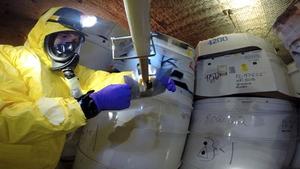Radiation risksA second drum at nuke waste repository poses radiation leak danger
At a recent meeting of the New Mexico Legislature’s Radioactive and Hazardous Materials Committee in Carlsbad, officials were informed that a second waste drum containing nuclear materials, could also contain the same mix of ingredients as the waste drum from Los Alamos National Laboratory (LANL) which caused a radiation leak at the Waste Isolation Pilot Plant (WIPP) in February.

Leaking nuclear waste drums in New Mexico // Source: nmlegis.gov
At a recent meeting of the New Mexico Legislature’s Radioactive and Hazardous Materials Committee in Carlsbad, officials were informed that a second waste drum containing nuclear materials could also contain the same mix of ingredients as the waste drum from Los Alamos National Laboratory (LANL) which caused a radiation leak at the Waste Isolation Pilot Plant (WIPP) in February.
“It’s concerning that just a couple months ago, the scope of the problem was presented to us as one drum,” said state senator and chairman of the committee, Peter Wirth. “Now the scope being represented by the lab involves more high-risk drums.”
Authorities have yet to determine what exactly caused the radiation leak which exposed more than twenty WIPP workers to radiation. “We need to know what the cause is. We can’t really reopen WIPP until we know what the cause is, and until then we won’t know that it won’t happen again,” said Don Hancock, director of the nuclear waste safety program at the Southwest Research and Information Center.
The Santa Fe New Mexican reports that Terry Wallace Jr., LANL’s WIPP recovery manager, told the committee that the suspected drum housed in Panel 6, contains the worrisome mix of waste: organic kitty litter, acid neutralizer, and a lead-laden glove used during the treatment of cold war-era waste at LANL. Officials had already acknowledged in July that a lead-tainted glove had been left in the drum that burst in February, noting that the glove may have contributed to the chemical reaction which caused the radiation leak at WIPP.
According to Wallace, sixteen waste drums from LANL are reported to contain disturbing mixtures of waste, with eight drums considered highly worrisome. Just two drums, however — the leaking drum stored in Panel 7 and the drum housed in Panel 6 at WIPP — contain the same potentially reactive elements.
Wallace’s report to the committee admitted the failure of LANL to properly ensure the safety of work conducted by its waste packaging contractor. To which Wirth noted that “there was also an acknowledgement from the Department of Energy that over the years, the safety culture at WIPP has slipped. The question becomes, ‘what comes next?’ ”
WIPP is set to release a recovery report in response to the February radiation leak, but Hancock is skeptical of the report’s findings, considering that the cause of the chemical reaction which led to the radiation leak remains unknown, despite attempts by scientists from several U.S. nuclear labs to re-create the chemical reaction. “They want to know what the cause is, too. My concern, frankly, is they’re eventually going to decide that a plausible explanation is good enough,” Hancock said. “That’s not good enough for me, and it shouldn’t be for anybody. I think it’s very likely we won’t know what the cause is. That creates a real conundrum.”
